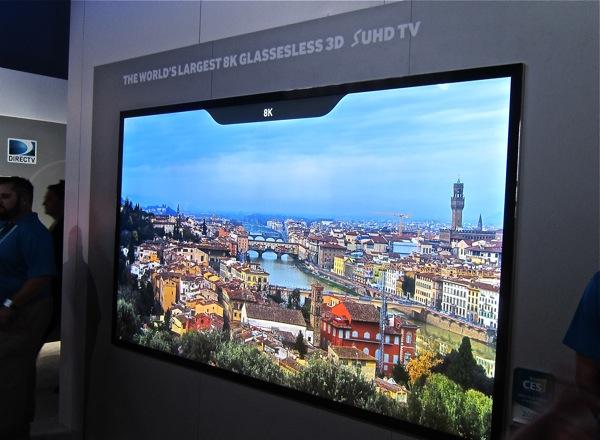Should You Wait to Buy Your Next TV?

Understandably, many consumers waited years for color television to come down in price. I still remember relatives and family friends claiming that they were waiting for them to be perfected. If by “perfected” they meant that they wanted to see the technology stabilize, they’re waiting!
Technology is never stable. While the Ian Malcolm character in Jurassic Park may have said, “Just because you can doesn’t mean that you should,” (truly an odd statement coming from a scientist—oh wait, it came from a screenwriter) there’s always something new and enticing just over the next hill.
Even today, with the move to Ultra HD and its obvious enticements, engineers in labs everywhere (but mostly in Japan, Korea, and China) are winnowing away on models for 2017 (2016’s sets are already set in stone). Meanwhile, supervisors are analyzing their options 2018 and beyond. In just the past 15 years or so we’ve seen the transition to HD, digital displays, flat panels, HDMI, LCDs (first with fluorescent backlighting, then LEDs, and now quantum dots), DVDs, Blu-rays, video streaming and downloading, smart TV apps, 3D, 4K, Ultra HD, OLEDs and (soon) advanced color for UHD plus high dynamic range (HDR) and Ultra HD Blu-ray.
It’s all confusing enough to drive the average consumer back to the multiplex, where he or she can enjoy digital projection, 3D, Atmos audio, IMAX, Big-D, Prime, pre-show advertisements, and the latest exhausting, computer enhanced alien attack on New York or a San Andreas-ed Californiaall accompanied by stale popcorn and sticky floors.
But I digress. When a manufacturer shows an 8K Ultra HDTV prototype at CES (as some have recently, even while surrounded by their new 4K models), the average consumer has to wonder if delaying a purchase for a couple of years might be the smart move.
Sales of flat screen TVs have already leveled off. The favored explanation for this is that most folks already have a flat screen set. Many buyers are also stuck on the long established habit of only replacing their TV every ten years or so. Combine that with the “promise” of even more goodies next year and you have to wonder how many of today’s consumers are also waiting for “perfection.”
The computer paradigm hasn’t just affected television. It has permeated technology in general. That’s not a bad thing; we all want better, and we want it yesterday. But perhaps it’s time for at least the basic parameters of Ultra HD to settle down. Fortunately, to an extent, they have. What we can expect soon in addition to 4K resolution will be advanced color depth (10-bits per color rather than today’s 8-bits), a wider range of colors (the P3 color gamutsimilar to the color gamut used in digital cinema), and high dynamic range (HDR).
We’ll also see Ultra HD Blu-ray, which may well become the only source that reliably offers all of these advances. Don’t even think about seeing “full Ultra HD” on broadcast. After spending millions on the transition to HD little more than 10 years ago, do you really think terrestrial stations will spend more to offer Ultra HD any time soon? Ditto for cable and satellite providersunless they can extract even higher monthly fees from their customers, which may well drive many of those customers to downloading and streaming.
But do you think getting your programming from the Internet is the answer? As the pipes become more and more clogged, offering Ultra HD will require massive compression, which might well drive the quality of Ultra HD downloads (and certainly streamingmost viewers want their shows now) below what can be achieved even from today’s plain vanilla HD Blu-ray format.
But a word to potential Ultra HD Blu-ray providers: If you expect that format to succeed, resist the temptation to make it available only at boutique prices!
So what about the other improvements some would like to see from Ultra HDthings like 12-bit color (or higher), a Rec.2020 color gamut (which will require 12-bit color, and may turn out to be both technically impractical and perceptibly troublesome), advanced color subsampling (4:2:2 rather than the 4:2:0 we have today and will continue to have with Ultra HD for the foreseeable future), and even high frame rate (hooray, soap opera for allbuilt into the source!) Some or all of these may all come in time, but I wouldn’t put off buying an Ultra HD set waiting for them.
If you want to be reasonably future proof, however (though future-proofing can never be guaranteed) insist that the Ultra HD set you buy today can handle 10-bit color from input to screen (without downconverting to 8-bits for internal processing), accurately produce a P3 color gamut (preferably switching automatically between P3 and today’s Rec.709 HD standard, as needed by the source), and accommodate HDR-graded material.
Most of today’s Ultra HD sets do 4K, together with HDCP 2.2 (the copy protection common on Ultra HD material), HEVC (otherwise known as h.265, the compression codec most widely used for Ultra HD), and (usually) at least one HDMI 2.0 input. But they don’t offer advanced color (at least in the form of an accessible P3 gamut) or HDR. We expect to see more Ultra HD sets later this year that do, though it’s unlikely they’ll carry bargain prices. And there’s no guarantee that sets currently lacking such features can be upgraded to them with new firmware. It’s possible that a set’s hardware will place a limit on what can be done in firmware. If a salesman tells you otherwise, I’d get it in writing!






























































